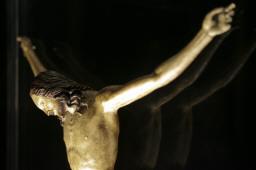A wooden carving of Christ on the cross recently attributed to Renaissance giant Michelangelo will head off on tour around Italy after proving a big draw at the Italian parliament over the last month.
Almost 30,000 people came to the Chamber of Deputies to see the cross, Culture Minister Sandro Bondi said, announcing that the success of the initiative had led him to think of other shows in parliament.
''Italian museums are brimming with marvelous works. We could put on a show every three months,'' he said.
One prime candidate was an Antonello da Messina that is currently being restored, Bondi said, while the Senate might also ask Egypt for a statue of Tutankhamun that was restored in Italy.
The Michelangelo cross, which has been attributed to a young Michelangelo, is set to be packed up and exhibited in Trapani from March 6-20, Palermo from March 22 to April 3 and finally in Milan for ''a couple of months'' from April 6, Bondi said.
There, at the Castello Sforzesco, it will be united with Michelangelo's famous Pieta' Rondanini, a glory of his later years.
''Finally the young and the mature Michelangelos will be able to talk to each other,'' Bondi said.
He said that it would also ''probably'' go on tour abroad before finding a permanent home in Florence's Bargello museum.
The cross, which only came to light four years ago, was bought from a Turin art dealer last month in one of the Italian state's most important acquisitions in years.
The Italian state paid the arts dealer, Giancarlo Gallino, 3.25 million euros for the work.
The price of any of Michelangelo's undisputed works would be countless times more in the unlikely event of one coming onto the market.
Art expert Vittorio Sgarbi, a supporter of the attribution, said the state had ''effectively got a Michelangelo at the price of a Sansovino''.
The limewood carving made its first-ever public appearance in Florence in 2004, shortly after its new attribution.
It was displayed for four months at the Tuscan city's Horne Museum before returning to Gallino's collection.
Earlier that year experts attributed it to Michelangelo, who lived from 1475 to 1564.
It was tentatively dated to 1495, when the artist was 20.
The experts were convinced by the style of the piece rather than documentation.
The 41.3cm carving was assessed by a mixed team of professors and scientists from Florence, Siena and Perugia universities, who tested it with CAT scans and examined it for the anatomical accuracy for which Michelangelo was renowned.
ANATOMICAL ACCURACY.
They reported that the posture, bones and musculature were ''perfectly in keeping with the body of a 30-year-old man who had died less than 48 hours previously''.
The custodian of Florence's Santo Spirito Church, Niccolo' Bichielli, is known to have allowed Michelangelo to study corpses but many believe he was also allowed to dissect them.
Although dissection was illegal, Michelangelo felt it was the key to understanding the body and portraying it realistically.
According to the Florentine painter and writer Giorgio Vasari, a contemporary of Michelangelo, the artist ''very often used to flay dead bodies in order to discover the secrets of anatomy''.
In addition, studies of the cross found that the 20-year-old Michelangelo ''probably changed his mind halfway through the sculpture''.
Initially, the Christ's head was too bowed for the slant of the body so it was lopped off and reattached with a wedge of wood at an accurate angle.
Florence Heritage Superintendent Cristina Acidini said this was indicative of ''a full-blown artistic rethink'' typical of Michelangelo.
While Michelangelo is traditionally known for the daunting scale of his pieces, Perugia University's Giancarlo Gentilini explained it was highly feasible he would have created such a small, detailed sculpture during this period.
''The young Michelangelo had close ties to the circle of (Florentine monk Girolamo) Savonarola, which was responsible for the spread of these small crucifixes,'' the professor noted.
''There would have been plenty of opportunities to carve such images and it's very likely that one of his principal customers, the Dominican monks in Bologna or Lorenzo di Pierfrancesco de Medici, would have requested one''.









